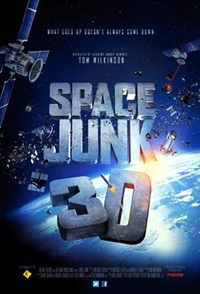Review: Space Junk 3Dby Jeff Foust
|
| Space Junk 3D takes advantage of the state of the art in cinema technology to better communicate the threat or orbital debris and potential ways of dealing with it. |
Fortunately, the debris did stay clear of the station, and the station’s crew exited the Soyuz capsules shortly after the object’s closest approach. It wasn’t the first time that station crewmembers had to shelter in their Soyuz vehicles because of orbital debris. In an incident last June, for example, an object passed just 260 meters from the station. Ironically, the object that passed close to the station this time around was itself the result of a collision: it was debris from the February 2009 collision of the Iridium 33 communications satellite and the defunct Russian Cosmos 2251 satellite.
That collision, and the close calls experienced by the ISS, have raised awareness of the threat posed by orbital debris, aka space junk. However, the topic is still somewhat abstract. After all, the debris objects themselves are visible only to powerful radars and telescopes, and the actual collisions, like the Iridium-Cosmos event in 2009 or the Chinese ASAT test two years earlier, are not witnessed. A new short film, Space Junk 3D, takes advantage of the state of the art in cinema technology to better communicate the threat and potential ways of dealing with it.
Space Junk 3D, currently screening in a handful of theaters that are primarily associated with museums, is intended to bring the issue of orbital debris to the very big screen. Designed for IMAX 3D theaters, the film offers plenty of dramatic visuals, both real and animated, to describe the threat of orbital debris. While narrated by British actor Tom Wilkinson, the central figure in the 40-minute film is Don Kessler, the former NASA scientist who led some of the early studies of the subject, long before it appeared on the public’s radar. (Kessler is perhaps best known for promulgating the concept known as the Kessler Syndrome, where the density of debris in a particular orbit reaches the point where debris creates a self-sustaining cascade of impacts, effectively making that orbit unusable.) Kessler provides the expert voice describing the growth of debris and ways to address, and perhaps eventually resolve, this problem.
| At one point the film shows a computer animation of the future collision of the Milky Way and Andromeda galaxies, something that is visually stunning on a giant 3-D screen, but has nothing to do with orbital debris. |
The film at times makes good use of its giant three-dimensional canvas, primarily in the form of computer animations that illustrate the growing population of debris and what the effects of debris collisions can be. The film also tries to be forward-looking, displaying at the end some of the concepts that researchers have proposed in recent years to capture debris or deorbit satellites at the end of their lifetimes. The film does look perhaps too far ahead, envisioning a fleet of orbital tugs—effectively space garbage trucks—gathering debris in their cargo holds and returning them to a giant space station, something that is likely many decades down the line at a minimum.
Yet at other times Space Junk 3D seems to lose focus. At one point the film shows a computer animation of the future collision of the Milky Way and Andromeda galaxies, something that is visually stunning on a giant 3-D screen, but has nothing to do with orbital debris beyond the fact that there are collisions in nature as well. Some of the non-CGI footage also seems a bit contrived, such as when, early in the film, Kessler is flown to the rim of Meteor Crater in a helicopter. Ostensibly it’s to illustrate that cosmic collisions happen in nature, but it has little to do with orbital debris itself.
Those issues aside, Space Junk 3D, does a good job illustrating the problem of orbital debris that can otherwise be difficult to visualize. In a discussion after a screening of the film at the Smithsonian’s National Museum of Natural History in Washington in mid-March, producer Kimberly Rowe said she was drawn to the topic precisely because of the lack of visuals. “It left you wanting to know more, and it’s also incredibly visual, yet there were no visuals to really see with this,” she said of the subject of orbital debris.
The screening in Washington was part of the DC Environmental Film Festival, a deliberate choice by the filmmakers because of how their perceptions about the topic changed while making it. “When we started to make the film, it was a space film,” said director/producer Melissa Butts at the screening. However, soon after starting work on it, she said, the environmental implications became clear and thus emphasized more in the final product. While not a perfect film, Space Junk 3D, does offer audiences a fascinating, and at times sobering, look at a problem that is only becoming more serious, as the crew of the ISS is discovering.
